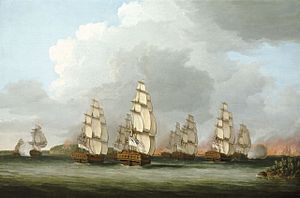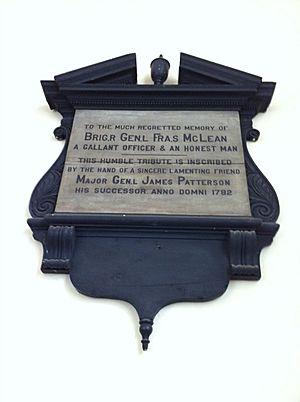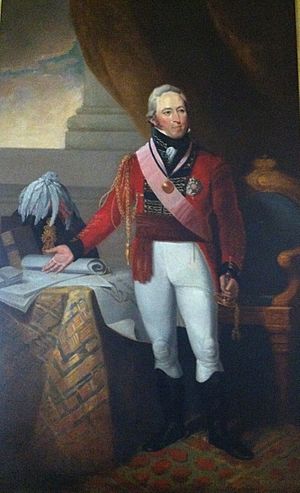New Ireland (Maine) facts for kids

New Ireland was a special area in what is now Maine, USA. The Kingdom of Great Britain tried to make it a new colony twice. This happened first during the American Revolutionary War and again during the War of 1812.
During the American Revolution, New Ireland lasted for four years. In the War of 1812, it lasted for eight months. Each time, the British gave the land back to the United States. This was part of peace agreements like the Treaty of Paris and the Treaty of Ghent.
Contents
New Ireland During the American Revolution


In 1779, the British planned to take over parts of Maine. They especially wanted the area around Penobscot Bay. Their goal was to turn it into a new colony called "New Ireland."
This idea was supported by Loyalists, who were people loyal to Britain. Dr. John Caleff, John Nutting, and William Knox were some of them. They wanted New Ireland to be a permanent home for Loyalists. It would also serve as a military base during the war.
The British Arrive in Maine
On May 30, 1779, eight British warships left Halifax. They carried 640 soldiers. General Francis McLean led these forces. The ships sailed into Castine's harbor, landed troops, and took control of the village.
The British then started building Fort George. This fort was placed on a high point of the peninsula. It was meant to protect their new territory.
The Penobscot Expedition
The Commonwealth of Massachusetts was worried about the British invasion. They sent a large military force called the Penobscot Expedition. Massachusetts general Solomon Lovell and Continental Navy captain Dudley Saltonstall led this group. General Peleg Wadsworth also helped. Colonel Paul Revere was in charge of the weapons.
The American force was very large. It included 19 warships and 25 support ships. They had a total of 344 guns.
The Battle and British Victory
General McLean and his British soldiers were greatly outnumbered. But they managed to defend Fort George for 21 days. The British forces included the 74th Regiment and the 82nd Regiment.
British reinforcements arrived, led by Collier, and the Americans were defeated. The American ships were blocked from escaping by the Royal Navy. So, the American soldiers burned their ships near what is now Bangor. Then they walked home.
This battle was a huge victory for the British. The failed Penobscot Expedition cost the Americans a lot of money and 43 ships. It was the biggest American naval defeat until Pearl Harbor in 1941. The British 74th Regiment stayed in the area until the war ended.
Life in New Ireland
The British set up a fort under the command of Campbell. About 30 houses were near the fort, occupied by Loyalists. The fort held captured American privateers (ships that attacked enemy vessels). It also traded with Halifax and New York.
After the war ended in 1783, the idea of New Ireland was given up. The Treaty of Paris officially ended the war. This treaty was not clear about the exact border between Maine and the British areas of New Brunswick and Quebec.
Loyalists Move to Canada
Many American Loyalists in the area moved east after the war. They went to the Canadian Maritimes. Some even towed their houses behind their boats! These people became known as United Empire Loyalists.
They crossed the new border at the St. Croix River. They helped establish St. Andrews, one of the oldest towns in New Brunswick. Many soldiers from the 74th Regiment also chose to settle in St. Andrews. They received land there instead of returning to Britain.
In 1784, New Brunswick was separated from Nova Scotia. It was meant to be the new Loyalist colony. It was planned to be named "New Ireland," but that name was not used. Instead, it became New Brunswick.
The story of New Ireland and the Penobscot Expedition is featured in the 2010 novel The Fort by British author Bernard Cornwell.
New Ireland During the War of 1812
During the War of 1812, the British tried to create New Ireland again. In August and September 1814, Lt Governor of Nova Scotia John Coape Sherbrooke sent a naval force from Halifax. Vice Admiral Colpoys led 500 British troops.
Their goal was to conquer Maine and restart the colony of New Ireland. In just 26 days, they took control of Hampden, Bangor, and Machias. They destroyed or captured 17 American ships.
British Occupation and Return to the U.S.
The British won the Battle of Hampden. They occupied the village of Castine for the rest of the war. They rebuilt Fort George, used a former American fort, and built three new forts there.
Just like in the Revolutionary War, the British wanted to make Maine part of Canada. A history professor, George F.W. Young, said the British "wanted to extend the border back down to what they thought was the historic frontier."
The Treaty of Ghent ended the War of 1812. This treaty returned the territory to the United States. The British left in April 1815. When they left, they collected £10,750 from taxes they had charged at Castine.
This money, called the "Castine Fund," was later used for good causes. It helped pay for a military library in Halifax. It also helped start Dalhousie College, which is now Dalhousie University. Dalhousie University even has a street named "Castine Way."
Images for kids


